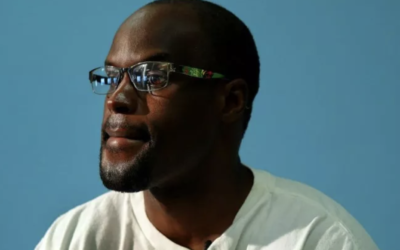Walking out the front door of prison. For those of us that live inside these walls and fences, this is the moment to moment dream that permeates our incarceration experience. We yearn to be reinstated to a status where we feel human again — to begin anew the gift of living verses the curse of mere existence. We focus so intently on this being the final act of our incarceration that we often overlook a crucial fact: the front door is not a magical portal. Just because we have finally passed through the front gates does not mean that everything will magically fall into place and turn into happily ever after.
Even though the newly released typically have their basic needs of housing, clothing, and food met through either family or community resources, there is frequently a disconnect between pre-release and post-release services because they fail to intersect in a substantive way. This needs to be corrected. We need to develop reintegration programs that allow both stages of the release process to meld smoothly in order to increase the health of our communities and decrease recidivism.
I believe that the process of transition from incarceration to freedom should be referred to as reintegration because this term suggests an inherent level of the intimacy that is not present within the impersonal concept of “re-entry.” In order for a justice involved citizen to successfully reintegrate back into society, they must first FEEL like they can be a part of the community. We can foster this sense of connection before they are released, by putting forwards the effort to raise their awareness of transitional issues they will face.
Earlier this year I was one of seven prisoners selected to participate in a summer work-study with eleven students in the Honors Program at the University of Washington. During this work-study, I was teamed with one other prisoner, and four of the students from the UW. Two of these students are officers of a student organization at the UW called Huskies for Opportunities in Prison Education — HOPE. Prior to the start of the work-study, we (the seven prisoners) outlined three separate issues/areas that we wanted to develop proposals on to give the Washington State Department of Corrections (WA/DOC).
The area that I focused on was reintegration, and the need for a change in the conventional thinking regarding this critical stage of the incarceration process. Through our collaborative efforts, the six of us developed a 12 week Reintegration Skills Program for prisoners who have 12 months or less remaining to serve on their sentences. The class would meet once a week for 3 hours, have weekly homework assignments, and be facilitated by the seven prisoners participating in the work-study.
Beyond my personal interest, I am motivated by the fact that over 96% of the men and women that are incarcerated in this country will at some point be released from confinement. With our current national prison population at approximately 2.2 million people, this equates to a staggering 2.1+ million men and women that will be released back to our communities. Reintegration is a challenge that every one of them must face. In many ways, these challenges may seem simple, however they expand to all aspects of life. A Reintegration Skills Program implemented and effectively made available would aide in this process by raising the awareness of those being released, and would further simplify many difficult tasks that may seem commonplace to someone that has never been incarcerated.
Our model of the Reintegration Skills Program is heavily influenced by various adult education theories. The curriculum of this program consists of things that are necessary and useful in the outside world. It is my belief that participation in this program should be voluntary, which will allow facilitators to rely on the intrinsic motivation of each person to maintain focus and forwards momentum. This is important because the flexibility of the curriculum will be most beneficial to a group that actively wants to be there. Every three hour class will involve receiving a constant flow of feedback from the students in order to gauge what exactly they need.
The Reintegration Skills Program as proposed is structured as follows:
FINANCIAL EDUCATION (2 weeks):
The program will use an abbreviated and modified version of a financial literacy program put together by the FDIC called “Money Smart”. This program has been successfully implemented in multiple different correctional facilities, following a partnership with the FDIC and the Federal Bureau of Prisons in 2004. The specific breakdown of modules are:
Check It Out: Covering the basics of checking accounts and how to open and manage one. Week 1 (120 minutes)
Money Matters: Understanding how to save and manage money to maximize income and decrease spending. Week 1 (60 minutes)
Charge it right: Explain why credit is important, how to determine if you are ready for a credit card, and how to open and manage a credit card. Week 2 (120 minutes)
Financial Recovery: Learn what steps are appropriate to recover financially after a crisis and rebuild credit. Week 2 (60 minutes)
DIGITAL AND MOBILE LITERACY (2 weeks):
This program will not only provide computer literacy training but also provide mobile information literacy. The specific breakdown of the modules are:
Computer Basics: Introduces what a computer is and the basics on how to operate a computer using an operating system and a mouse and a keyboard. Week 3 (60 minutes)
Introduction to Mobile Technologies: Introduces mobile devices and their applications. Demonstrate basic operation of tablets and mobile phones. Week 3 (60 minutes)
World Wide Web: Introduces the concept of the web and its applications. Covers how to use the web as a resource to search and find information. Week 3 (60 minutes)
Productivity Programs: Explores the common productivity applications such as Word, Google Maps, etc. Week 4 (60 minutes)
Working Online and Using Information: Covers internet privacy and security, online etiquette, and working in online environments. Week 4 (60 minutes)
EMOTIONAL INTELLIGENCE (4 weeks):
This program will aim to facilitate healthy relationships upon release. Due to the fact that incarcerated individuals are most often completely isolated from society for years at a time, providing emotional/social skills is just as important as providing tactical/physical skills. This is a key step in the reintegration process as it will further the development of connections to the community and will make help easier to find. The specific breakdown of the modules are:
Effective Communication: This should cover the most basic level of communication, as in what is appropriate based on the current standards. This will include sample social situations (roleplay) covering various social norms, individual roles and covering how communication (both verbal and nonverbal) reduces uncertainty. Week 5 (180 minutes)
Building Healthy Relationships: This is one of the most essential skills to learn upon release, as the new relationships to be made are important to maintaining a healthy life post prison. This module should cover when to walk away/ what makes relationships unhealthy, and how to build and sustain a healthy relationship. Week 6 (180 minutes)
Violence Prevention and Conflict Resolution: This is an important area to address in order to raise awareness of constructive methods to maintain healthy relationships. This module should cover how to remove yourself from an unhealthy relationship, alternatives to reacting violently/developing empathy, and both verbal and nonverbal ways of effectively addressing conflict. Week 7 (180 minutes)
Self Empowerment: Given that there will be many hardships and denials during the reintegration process, it is important to learn how to identify successes in order to overcome the sense of defeat attached to the first no/first failure, and how to adopt and maintain a positive solution-oriented perspective. Week 8 (180 minutes)
FINDING A POSITIVE COMMUNITY (4 weeks):
This portion of the program will utilize a combination of resources aimed towards the final step of incarceration: release. In order increase successful reintegration, it is paramount to find local positive community relationships that provide both emotional support and essential resources. The specific breakdown of the modules are:
Survival: This will include finding the essential resources that will be needed immediately upon release, such as finding housing/shelter, food, clothing, and medications. Additionally, developing mobility through securing a drivers license and insurance, or navigating the public transit service are key issues that need to be covered. Week 9 (180 minutes)
Stabilization: This entails the transition to independence. This will include topics such as finding appropriate treatment for any mental health/sobriety needs, such as counseling and/or AA/NA sources available locally. Further topics addressed will be rebuilding family ties/connection, and the basics of how to find jobs and identify the viability of employment options. Week 10 (180 minutes)
Self Sufficiency: At this stage integration is near. A continuation of employment related issues should be covered. Things such as clothing, interview preparation, resume basics, and actions that must be taken in order to remain self-sufficient (like paying rent, utilities, and other expenses) should be included, along with the need to develop and maintain positive connections by getting involved in community life. Week 11 (180 minutes)
Integration: This final segment of the program is geared towards ensuring that the participants feel ready to be released and that there is a place for them in the community. Optimally, there will be outside guests present that are active in the various mentor/mentee programs that are developing in local communities. This final class will be largely open forum in order to assist with the specific areas of anxiety that respective participants express. Week 12 (180 minutes)
The homework assignments are discretionary, but I have chosen to coordinate with an organization local to Seattle called Civil Survival, which was founded by an attorney named Amanda Dubois. She identified an area of need that is crucial to successfully reintegrate into society. The critical thinking skills necessary to navigate simple legal documents. Things like negotiating a lease, an employment contract, insurance contracts, etc. I am currently coordinating with Civil Survival to secure these modules which I hope to make available at a later time.
Finally, we must be ever mindful of this: justice involved citizens face a myriad of challenges when they begin the reintegration process. By providing them with the skills and awareness they need, coupled with constructive methods for overcoming these hurdles, we can prepare them to succeed during this often overwhelming transition.
I am deeply appreciative to adopt-an-inmate.org for everything they do, and for giving me the chance to provide this information. I encourage you all to remain steadfast in your commitment. Together we can make a difference.
Very truly yours,
Jacob Ivan Schmitt






0 Comments